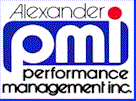
Building Better Performance Management Systems
 |
Building Better Performance Management Systems |
| The performance management process is the link between organizational vision and the individual action and empowerment of itsí people. It is the engine that drives the strategies to their destination. It is the just process that recognizes individual performers for their contributions. | |
Service
Description
|
Alexander Performance Management, Inc. has been installing effective and stable Performance Management Systems in both the private and governmental sectors for a decade. Each system is customized to the culture, uniqueness and mission of the client organization. All include a three dimensional view of employee performance that is both logical and just in the eyes of employees and effective as a managerial tool to implement strategy and focus resources. It is the process, which slashes grievance costs, builds employee loyalty and builds a sense of partnership in organizational success. |
Results
from an Effective Performance management Process
|
∑ Every employee constructs their critical few Key Result Areas and how success will be targeted. ∑ It doesnít play favorites and is applicable from top executives to hourly workers. ∑ Is constructed to meet the needs of the organizational realities with the involvement of a broadly selected advisory group from the client organization. ∑ Not a one-size-fits-all process, each set of performance criteria is contoured around the results the job was invented to deliver and the environment in which the employee operates. ∑ Results targeted are prioritized and rewarded based upon relative importance to the organization. ∑ Sets up a solid base upon which to build your pay-for-performance process. ∑ Provides a clear connection between individual effectiveness and rewards received. ∑ Includes the most important behaviors and skills to both keep and build customized to each job and employee. |
Implementation
Process
|
1. The consultant meets with top management to review current strategies and linkages with the performance planning and evaluation process. 2. The consultant collects information and meets with some selected employees to gain their concerns and ideas. 3. The project is scoped out and segmented for client budgeting and approval. The project advisory group is identified. 4. Initial process and forms design developed for review by the client and advisory group. 5. A behaviors and skills survey is completed in order to decide which of the more subjective performance areas are important based upon the organizational culture and its aspirations. 6. All necessary forms and userís guides drafted for final review by the advisory group and approval by the executive team. 7. Final forms and guides published. 8. Orientation for employees, supervisors and management. 9. Training sessions provided so that each employee has the first opportunity to develop his or her initial performance criteria. 10. Technical assistance is provided to those who need extra help in defining their job contributions. 11. The consultant conducts four quarterly implementation reviews for to deal with special problems or issues. |
Organizational
Participation
|
Typical positions up to the CEO, President, Managing Director, and City Manager are included in the process. Exempt positions will have greater results orientation than those for hourly people. All will have a direct connection between the level of performance to achieve organizational results and the rewards those results should yield. |